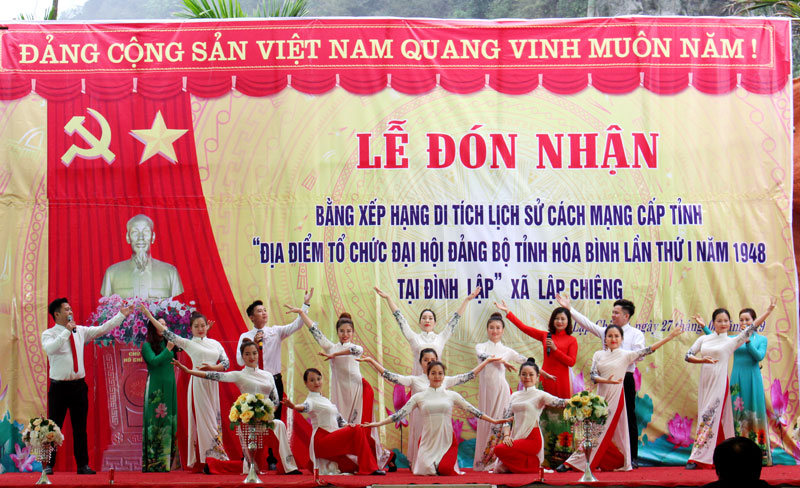
(HBO) – Lap communal house was previously located in Ha Bi commune, now Lap Chieng commune, Kim Boi district, Hoa Binh province. From May 21-25, 1948, the first congress of the provincial Party Committee took place there. This was an important historical and political event which marked the maturity of the provincial Party Committee in the resistance war against French colonialists.
 Art
performance celebrates recognition of Lap communal house as provincial
revolutionary historical relic site.
Art
performance celebrates recognition of Lap communal house as provincial
revolutionary historical relic site.
According to the elderly in the area, Lap
communal house was erected at the end of the 19th century. It was mainly made
of wood with one compartment and two lean-tos. There is an alter inside called
Cung So to worship the gods of the villages named "Ong Moi” and "Ba Nanh”.
People hold festival at the house on the eighth day of the first lunar month
annually.
With its historical and political significance,
Lap communal house was recognised as a provincial revolutionary historical
relic site on January 5, 2019, by the provincial People’s Committee. This is an
important legal foundation for the management, protection and promotion of the
house’s values in the short and long run. It is also an honour and pride of the
Party Committee, authorities and people of Kim Boi district./.
The People’s Committee of Lac Son district held a ceremony on April 28 to receive the provincial relic certificate for the ancient rock carving site at Suoi Co stream, located in My Thanh commune.
A special music show titled "The country is in the fullness of joy” has been held at Hoa Binh Square in Hoa Binh city in celebration of the 50th anniversary of the liberation of the South and national reunification (April 30, 1975–2025).
The People's Committee of Lo Son commune, Tan Lac district, has organised the local annual traditional stream fishing festival on April 19 - 20.
As a land deeply intertwined with human history and Vietnam’s millennia-long journey of nation-building and defence, Hoa Binh is often revered for its epic tales and legends.
Residents of Hoa Binh boast a rich cultural identity, reflected in their unique language, traditional attire, customs, and folk melodies – described as "sweet as honey, clear as a mountain stream.”
Lac Son district’s Vu ban town held the 2025 Truong Kha temple festival on April 12–13 (the 15th–16th days of the third lunar month). Since its revival in 2019, the festival has been organised every three years, preserving valuable intangible heritage while meeting the community’s cultural and spiritual needs.



 Art
performance celebrates recognition of Lap communal house as provincial
revolutionary historical relic site.
Art
performance celebrates recognition of Lap communal house as provincial
revolutionary historical relic site.